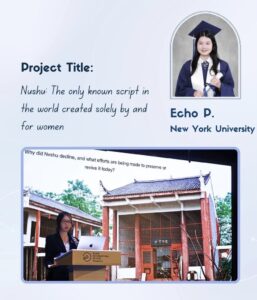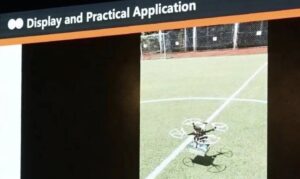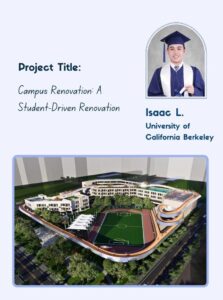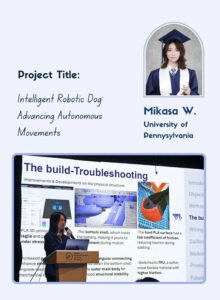Each year, senior students at BASIS International & Bilingual Schools take on independent senior projects that reflect their passions, curiosities, and ambitions. These capstone experiences are more than academic exercises—they are acts of exploration, problem-solving, and creative expression. Whether examining forgotten scripts, designing rescue-ready drones, or reimagining campus architecture, our seniors tackle complex questions and offer innovative solutions. The following projects from the Class of 2025 at BASIS International School Hangzhou showcase the incredible depth of their work, as well as the diverse paths they are preparing to pursue after graduation.


Senior Project Presentations
Project Title: Nushu: The only known script in the world created solely by and for women
Echo P., New York University

Abstract:
In a world where women were once denied the right to read and write, Nüshu emerged-a secret script created by women, for women. Through fieldwork in Jiangyong, I interviewed five Nüshu inheritors across three generations. I learned that Nüshu carries different meanings for each of them: sorrow, survival, joy, and memory. One elder (He Yanxin) told me she cries every time she sees Nüshu, while a younger inheritor (Yi Bingting) called it a language of freedom. These voices reminded me that Nüshu is not just a historical artifact, but a mirror reflecting each woman’s life, pain, and hope. I created a mobile stamp workshop and designed postcards based on my photos from the villages, inviting others to interpret Nüshu through their own stories. This project became more than research– it became a way of listening and of honoring voices once hidden.
Project Title: Autonomous Drone Design For Logistics & Rescue Missions
Hong G., Rice University

Abstract:
This project focuses on the development of an autonomous drone utilizing a Raspberry Pi system to enable fully automated navigation and obstacle avoidance. The drone is designed to follow a pre-determined route from its departure point to the destination without human intervention. In the future, additional functionalities will be integrated, including object recognition through an onboard camera and an attached robotic claw for grasping and transporting objects. These enhancements aim to expand the drone’s applications in logistics and emergency rescue operations.

To lay the groundwork for automation, a manually controlled drone was initially built to gather essential flight data, providing insights into stability, responsiveness, and environmental adaptability. The primary challenge lies in designing a fully functional autonomous drone that is both practical and accessible for everyday users, such as delivery personnel. In essence, this drone should be significantly more affordable than existing commercial models in the same category, ensuring widespread usability without compromising on efficiency and reliability. Overcoming these technical barriers will be crucial in advancing the drone’s capability for real-world applications. By developing a reliable and efficient autonomous drone, this project aspires to contribute to advancements in intelligent aerial transportation systems.
Project Title: Campus Renovation: A Student-Driven Transformation
Isaac L., University of California, Berkeley

Abstract:
This senior project reimagines spatial constraints as opportunities through the design of an elevated corridor system at BASIS International School Hangzhou. Nestled in the dense urban core of Qianjiang New City, the campus faces spatial shortages: crowded corridors and sports facilities, and an underutilized rooftop. Inspired by New York’s High Line Park and Henri Matisse’s “La Danse”, the proposal transforms the rooftop into a multifunctional “ribbon corridor” that weaves athletic and social spaces vertically. Using SketchUp and Rhino, the design evolved from an impractical spiral concept to a streamlined, curvilinear pathway that harmonizes aesthetics with functionality. The corridor not only reclaims 1,800m of rooftop space but also proposes future extensions to adjacent office towers and riverside parks, fostering school-community symbiosis. This project demonstrates how architectural innovation, rooted in art and pragmatism, can turn urban limitations into vibrant, inclusive landscapes.
Project Title: The Representation of Women’s Labor Conditions in 1920s Chicago Through the Lens of Chicago the Musical
Lisa Y., University of Southern California

This case study examines the representation of women’s labor conditions in 1920s Chicago as portrayed in the musical Chicago. The research explores the historical context of women’s labor during the industrial boom, focusing on issues such as workplace discrimination, sexual harassment, unequal pay, and limited career advancement opportunities, and how these struggles for autonomy, survival, and power are dramatized through the characters and themes in the musical. By analyzing key characters such as Roxie Hart and Velma Kelly, the study highlights parallels between the limited roles available to women in the workforce-primarily as factory workers, domestic servants, and entertainers-and the ways in which these characters navigate a male-dominated society. The research analyzes historical labor records, including wage documents, employment statistics, and workplace accident reports from Chicago’s manufacturing and entertainment sectors, alongside existing literature on women’s labor rights in Chicago, and a detailed examination of the musical’s themes.
Project Title: Intelligent Robotic Dog: Advancing Autonomous Movements
Mikasa W., University of Pennsylvania





